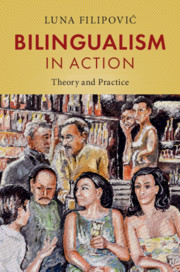Book contents
- Bilingualism in Action
- Bilingualism in Action
- Copyright page
- Dedication
- Contents
- Figures
- Tables
- Preface
- Acknowledgements
- 1 Introduction
- 2 Bilingualism Research
- 3 Introducing CASP for Bilingualism
- 4 Action Time
- 5 Bilingual Cognition
- 6 Bilinguals in Action as Language Professionals
- 7 Conclusions and Future Directions
- References
- Language Index
- Name Index
- Subject Index
7 - Conclusions and Future Directions
Published online by Cambridge University Press: 10 October 2019
- Bilingualism in Action
- Bilingualism in Action
- Copyright page
- Dedication
- Contents
- Figures
- Tables
- Preface
- Acknowledgements
- 1 Introduction
- 2 Bilingualism Research
- 3 Introducing CASP for Bilingualism
- 4 Action Time
- 5 Bilingual Cognition
- 6 Bilinguals in Action as Language Professionals
- 7 Conclusions and Future Directions
- References
- Language Index
- Name Index
- Subject Index
Summary
Life is all about connections. Rivers that run towards seas carry valuable nutrients that are then acquired, used and re-created as the same or similar nutrients, which then evaporate and fall down as rain into rivers that run towards seas. Language is all about connections too. In the flow of communication, we acquire, use and transform language and pass it on to the next generation of language-ready minds to start the process of acquisition, use and transformation of language all over again.
The more languages we speak the more minds we can connect with, which must be an advantage in itself. This has been the underlying tenet of this book, about to be concluded here. Bilingualism is good for you, regardless of whether and when there may be advantages or some (temporary, surmountable or compensated for) disadvantages in the process of becoming or being bilingual. Bilinguals (and multilinguals) can connect with more people through communication in different languages and they are also often bi-cultural (or multicultural), which enhances their adaptability to different environments and enriches their life experience.
- Type
- Chapter
- Information
- Bilingualism in ActionTheory and Practice, pp. 172 - 182Publisher: Cambridge University PressPrint publication year: 2019

